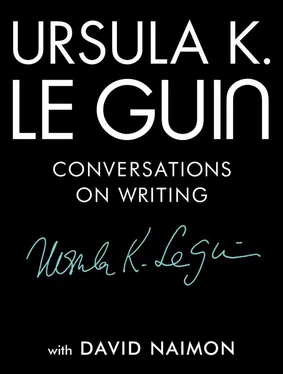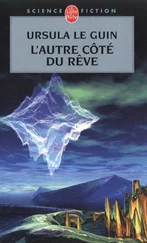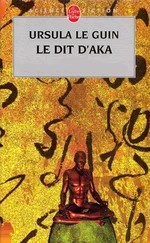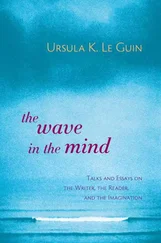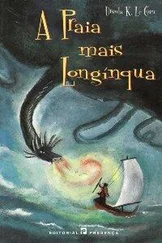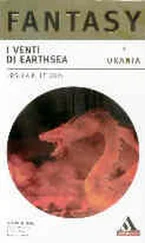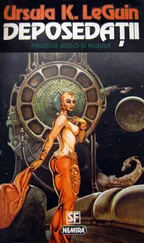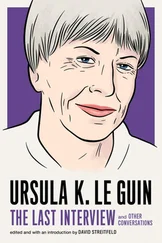DN:In “The Operating Instructions,” which comes from a 2002 talk at a meeting of Oregon Literary Arts, you write really wonderfully about an American-specific fear of imagination. In one of our past talks I mistakenly confused this with our resistance to considering genre fiction as literature. I wondered then if, now that genre fiction was finally breaking those walls down, that meant America was coming to terms with imagination in a healthier way. You pushed back and said that the question of America and imagination is a bigger and broader one than the question of genre fiction and literature but we never went further at the time. What is it about the American spirit that makes us fearful of the imaginative spirit?
UKL:That old essay is called “Why Are Americans Afraid of Dragons?” and it was written specifically about the American tendency to dismiss all fantasy, all highly imaginative fiction, as for kids, or as unimportant because it isn’t about what the stock market is doing today. The immediate profit attitude toward life. Dickens talks about it in his novel Hard Times , making fun of the completely “realistic” businessman who can’t think of anything but immediate use and profit and therefore loses any sense of there really being any future. This mind-set, as it comes through in education (Dickens was very clear about that too), is crippling to a child’s whole development. Because the imagination is simply a very large part of the way our minds function. To stint or stunt or be contemptuous of the imagination is a terrible thing to do, particularly to a young developing mind that needs to be able to think about anything—to imagine things, and be clear about the difference between what is imagined and what is real. I think children are much better at that than most adults give them credit for. They know when it is a fairy tale. And they often know when it is a lie. But still, both reason and imagination need training. They need exercise just like the body does. We train some of the rational faculties, but less and less is the imaginative given any place in American education. I think that is very scary.
FROM
“The Operating Instructions”
• • •
A poet has been appointed ambassador. A playwright is elected president. Construction workers stand in line with office managers to buy a new novel. Adults seek moral guidance and intellectual challenge in stories about warrior monkeys, one-eyed giants, and crazy knights who fight windmills. Literacy is considered a beginning, not an end
…Well, maybe in some other country, but not this one. In America the imagination is generally looked on as something that might be useful when the TV is out of order. Poetry and plays have no relation to practical politics. Novels are for students, housewives, and other people who don’t work. Fantasy is for children and primitive peoples. Literacy is so you can read the operating instructions. I think the imagination is the single most useful tool mankind possesses. It beats the opposable thumb. I can imagine living without my thumbs, but not without my imagination.
DN:You say something in your talk “The Operating Instructions” that fascinates me. That “home” isn’t your family, nor is the house where you live. Home is instead imaginary. And by imaginary you don’t mean illusory, but in some respects more real than any other place. You write, “Home, imagined, comes to be. It is real, realer than any other place, but you can’t get to it unless your people show you how to imagine it—whoever your people are.” Can you unpack that a little for us, the ways humans imagine “home,” create groups, invent ways to live, and imagine as a means of thriving?
UKL:A function of myth in what we used to call “primitive” societies, real myth as told seriously by serious grown-ups to others, perhaps one of its main functions, is telling us who we are. For instance, “We are the Diné,” or “We are the Apache.” And a very large part of knowing who we are is knowing where we came from, where we live now, and if there is a further home to go to, what might it be? Placing yourself among your people within a certain context on the Earth. And it seems to take a lively effort of the imagination to accomplish this, so all myths in a sense are “unrealistic.” And yet they are trying to get to the heart of one’s reality as a human being who is a member of a community. Which is kind of an important job.
DN:Right after this investigation of the imagination in the book we come across a talk you gave at the Conference on Literature and Ecology in 2005 called “The Beast in the Book,” where you talk about imagination in relationship to nature and the non-human other. You talk about the coexistence of animal and human in story, in folktales, fairy tales, and fables, about how only in the postindustrial age are animal tales considered only for children. It makes me think about one of the taboos in literary fiction, one that you see explicitly prohibited in the guidelines of many literary magazines, that of stories that have talking animals, or that are told from the imagined perspective of an animal. Do you think this limiting of the animal to children is a postindustrial phenomenon or an American postindustrial phenomenon?
UKL:It’s not just American. It includes European literature too. The thing is we don’t live with animals as we did. The relationship has changed immensely in the last two hundred years. You didn’t used to be able to get away from the animals. They were part of your life, absolutely essential to your well-being as fellow workers in the field, as your food supply, your wool supply, and so on. Now we get all that at an enormous distance. Now there are people who can’t be in a room with an animal. What would they have done a hundred years ago? I really don’t know. They would have to like it or lump it, I guess. Children grow up never touching any living being except another human being. No wonder we are alienated. We can live in the cities as if there were no other living beings on Earth. No wonder people get indifferent and think it doesn’t matter if you extinguish a species. You have to be in touch and we are not. I think that kids’ stories and animal stories are an imaginative way at least of being in touch. Therefore they are very important. But my opinion is not shared by a lot of literary people. Literary people tend to assume if it is about animals, it is probably sentimental. And sentimentality is the worst possible sin.
FROM
“The Beast in the Book”
• • •
Why do most children and many adults respond both to real animals and to stories about them, fascinated by and identifying with creatures which our dominant religions and ethics consider more objects for human use: no longer working with us, in industrial societies, but mere raw material for our food, subjects of scientific experiments to benefit us, entertaining curiosities of the zoo and the TV nature program, pets kept to improve our psychological health?
Perhaps we give animal stories to children and encourage their interest in animals because we see children as inferior, mentally “primitive,” not yet fully human: so we see pets and zoos and animal stories as “natural” steps on the child’s way up to adult, exclusive humanity—rungs on the ladder from mindless, helpless babyhood to the full glory of intellectual maturity and mastery. Ontogeny recapitulating phylogeny in terms of the Great Chain of Being.
But what is it the kid is after—the baby wild with excitement at the sight of a kitten, the six-year-old spelling out Peter Rabbit , the twelve-year-old weeping as she reads Black Beauty ? What is it the child perceives that her whole culture denies?
Читать дальше
